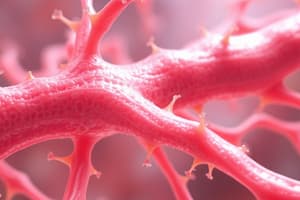Podcast
Questions and Answers
What are the six key components of type I hemidesmosomes?
What are the six key components of type I hemidesmosomes?
- BPAG2, Selectins, Connexons, Cx43, Integrin subunits α6 and β4
- Selectins, IgSF, Cadherins, Connexons, Cx43
- Integrin subunits α6 and β4, CD151, BPAG2, BPAG1e and plectin 1a (correct)
- Laminin-332, Keratin IFs, Connexons, Cx40, Integrins
What is the function of integrins in cancer progression?
What is the function of integrins in cancer progression?
- Supporting oncogenic growth factor receptor (GFR) signaling (correct)
- Promoting tight junction integrity
- Inhibiting cell migration and invasion
- Formation of gap junctions
What is the maximal functional pore size for gap junction connecting channels?
What is the maximal functional pore size for gap junction connecting channels?
- 10 nm
- 1.5 nm (correct)
- 5 nm
- 20 nm
What is the main consequence of inherited disorders associated with connexin mutations?
What is the main consequence of inherited disorders associated with connexin mutations?
What role does cell coupling via gap junctions play in embryogenesis?
What role does cell coupling via gap junctions play in embryogenesis?
Which type of cell junction connects the basal surface of epithelial cells to the underlying basal lamina?
Which type of cell junction connects the basal surface of epithelial cells to the underlying basal lamina?
What is the main transmembrane protein forming the tight junction strands?
What is the main transmembrane protein forming the tight junction strands?
Which type of junction mechanically attaches cells (and their cytoskeletons) to their neighbors or to the extracellular matrix?
Which type of junction mechanically attaches cells (and their cytoskeletons) to their neighbors or to the extracellular matrix?
In which type of junction are the transmembrane linker proteins members of the integrin family of extracellular matrix receptors?
In which type of junction are the transmembrane linker proteins members of the integrin family of extracellular matrix receptors?
Which type of cell junction mediates the passage of chemical or electrical transport across epithelial cells?
Which type of cell junction mediates the passage of chemical or electrical transport across epithelial cells?
Flashcards are hidden until you start studying
Study Notes
Hemidesmosomes and Cell Junctions
- Six key components of type I hemidesmosomes include integrins, collagen type IV, laminin, plectin, BP230, and keratin filaments.
- Hemidesmosomes anchor epithelial cells to the underlying extracellular matrix, stabilizing tissue structures.
Integrins and Cancer
- Integrins play a critical role in cancer progression by mediating cell adhesion to the extracellular matrix, influencing cell signaling, and promoting tumor cell migration and invasion.
Gap Junctions
- The maximal functional pore size for gap junction connecting channels is approximately 1.5 nanometers, allowing for the passage of ions and small molecules between adjacent cells.
Connexin Mutations
- Inherited disorders associated with connexin mutations often lead to functional impairment in gap junction communication, which can result in various types of tissue dysfunction.
Cell Coupling in Embryogenesis
- Cell coupling via gap junctions facilitates intercellular communication during embryogenesis, essential for coordinated development and the establishment of tissue patterns.
Epithelial Cell Junctions
- Hemidesmosomes connect the basal surface of epithelial cells to the underlying basal lamina, forming a critical interface for structural integrity.
Tight Junctions
- The main transmembrane protein forming the tight junction strands is claudin, which regulates paracellular permeability and maintains cell polarity.
Adherens Junctions
- Adherens junctions mechanically attach cells and their cytoskeletons to neighboring cells or the extracellular matrix, providing structural support and maintaining tissue integrity.
Focal Adhesions
- Focal adhesions are cell junctions where the transmembrane linker proteins belong to the integrin family, facilitating communication between the cytoskeleton and the extracellular environment.
Paracellular Transport
- Tight junctions mediate the passage of chemical or electrical transport across epithelial cells, regulating the movement of substances between adjacent cells.
Studying That Suits You
Use AI to generate personalized quizzes and flashcards to suit your learning preferences.




